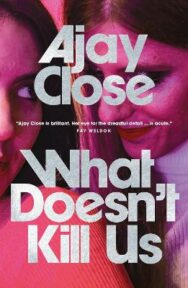‘As well as telling a good story, What Doesn’t Kill Us made me think.’
David Robinson is impressed by the ideas, language and storytelling in Ajay Close’s latest novel.
What Doesn’t Kill Us
By Ajay Close
Published by Saraband
The most shocking moment in The Long Shadow, ITV’s recent drama series about the five-year hunt for the Yorkshire Ripper, comes (spoiler alert) right at the end. Peter Sutcliffe has been caught, tried and sentenced and the police inquiry into what went wrong is just beginning.
Two officers are shown into the major incident room. Pinned to the wall in front of them are over 30 photofits, dating back to 1972, based on descriptions given to the police by women whom Sutcliffe had followed, attacked or left for dead. The colour drains from the investigators’ faces as they realise that nearly all of them are, very clearly, the same man. ‘Some of the women weren’t listened to,’ the (female) policewoman explains.
What women can, should, and actually did do in a society in which they are not being listened to is at the heart of Ajay Close’s novel What Doesn’t Kill Us, which is set in West Yorkshire at the time of the Ripper murders. Like David Peace’s Red Riding Quartet, it takes the core of the case and gives it a fictional spin: this time into a story, not of police corruption but of feminist radicalisation. In Close’s novel, as a man the media have called the Yorkshire Butcher carries on his killing spree in the background, the women in a feminist collective at 109 Cleopatra Street, in the inner Leeds suburb of Chapeltown, are working out how to fight back.
But how? This, remember, is the Seventies. Sexism isn’t just everyday but everywhere institutionalised. Benny Hill is on the box, Bernard Manning at the microphone, and builders wolf-whistle and catcall passing ‘dollybirds’ without a second thought. No-one seems to know any lesbians, and women at work are tolerated at best and ignored and insulted at worst, all fading to invisibility in middle age. Young or old, violence against them is commonplace. ‘What do you call a woman with two black eyes?’ goes one so-called joke of the time. ‘Nowt. She’s been told twice already.’
Liz Seeley, a policewoman who is a lowly part of the hunt for the Yorkshire Butcher, moves in with the Cleopatra Street collective in Chapeltown after she has been given a black eye by her boyfriend. There, she meets the kind of people she had never met before – most prominently, the charismatic, self-assured feminist intellectual Rowena, who is the other pivotal figure in the novel.
While a male detective interrogates errant husbands about their use of prostitutes (‘It’s all right, we’ve all done it’) in the living room, Liz is in the kitchen talking to their wives; a compromising enough job made unbearably so, and then she is tapped up by Special Branch to report on anything illegal her new flatmates get up to.
And there is, potentially, a lot to report. As the Cleopatra Street commune fleshes out what feminism ought to mean, Rowena makes the case for meeting male violence with a violent response of their own. Of course, they will lead ‘reclaim the night’ marches and lead demonstrations outside cinemas showing porn, but why shouldn’t they go further? What’s wrong, for example, with a bit of revolutionary justice against the local pimp? Or a carefully targeted firebombing? (Close’s 2015 novel A Petrol-Scented Spring deals with the repercussions of one such Scottish suffragette’s arson attack.)
For me at least, What Doesn’t Kill Us would fall flat on its face if it didn’t also show the excitement of ideas, if we couldn’t see why, looking back, Liz would see the year she lived on Cleopatra Street as the happiest of her life. This is where, though keeping quiet about what she actually does for a living, Liz finds togetherness, where her feminism blooms, where the balance between the world as it is and the world as it ought to be shifts and the potential for a more fulfilling future comes into focus. More than that, it becomes obvious. In one speech, Rowena asks a crowd of women to put up their hands if they have ever been raped by a stranger. Five do. No-one raises their hand when she asks if anyone has been raped by someone they know.
‘”Let me put that another way. Have you ever had sex with a boyfriend, or husband, or just a male friend, when you didn’t want to?”
An electric shock ran through the room. So many hands.’
The speech Rowena goes on to make, like Gloria’s ‘It is impossible to be a woman’ monologue in Barbie, has a power that is rooted in specificity, and indeed impossible to argue against. But Rowena takes the fight against male violence even further. If men won’t change, women should cut themselves off from them. The Lysistrata solution. No more (straight) sex.
Until I read the Afterword of Close’s novel, I’d never heard of the Leeds Revolutionary Feminists or the arson attacks on local sex shops at the time. Ditto with the Political Lesbianism pamphlet on which Cleopatra Street’s ‘Whose Side Are You On?’ pamphlet calling for a sex strike is clearly based.
Conveying the excitement of such ideas, and what they are a reaction against, is hard enough; showing how and why they mutate as part of the commune’s group dynamics is even harder. Somehow Close manages to do both at the same time as well as – and this is the really tricky bit, the fourth ball to juggle – indicating how easily those ideas might stray towards the absurd, as when Rowena indicates that a truly feminist collective wouldn’t have a male cat as a pet, never mind accepting as a commune member the mother of a young boy. One final point: although Close, like me, has probably spent more of her life in Scotland than her native West Yorkshire, she has its speech patterns and slang down to a tee. I have rarely (if at all) seen this done better.
She has the Seventies down pat too. Many of us who were young then look back in embarrassment at some of the attitudes we then had, even if we weren’t completely racist or male chauvinists. And without for a second suggesting that gender equality is even close to being achieved or that relations between men and women are hunky-dory, it would be hard to argue that both are vastly better than they were back then.
As well as telling a good story, What Doesn’t Kill Us made me think. Who or what, I wondered, made the biggest positive difference in relations between the sexes between then and now? Was it a woman, and if so who? A politician I’ve heard of like Barbara Castle, wielding power through legislation? Or – and this is the thought I’d never had – a feminist in a Leeds commune drawing a revolutionary line between what she would put up with and what she no longer could?
What Doesn’t Kill Us by Ajay Close is published by Saraband, price £10.99.














